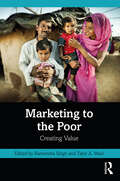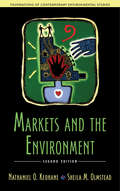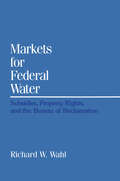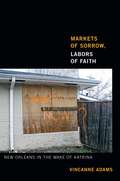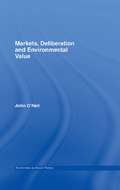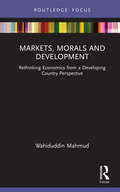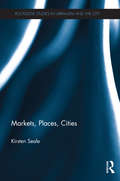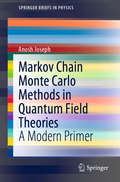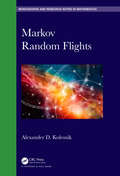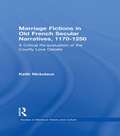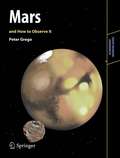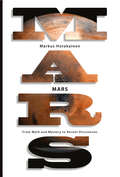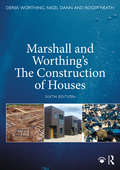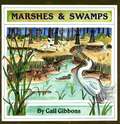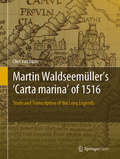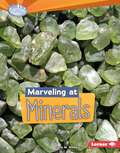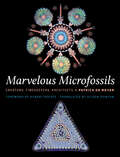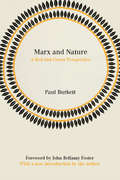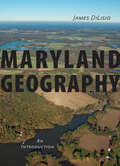- Table View
- List View
Marketing the Wilderness: Outdoor Recreation, Indigenous Activism, and the Battle over Public Lands
by Joseph WhitsonHow outdoor industry marketing promotes an image of &“the wilderness&” as an unpeopled havenMarketing the Wilderness analyzes the relationship between the outdoor recreation industry, public lands in the United States, and Indigenous sovereignty and representation in recreational spaces. Combining social media analysis, digital ethnography, and historical research, Joseph Whitson offers nuanced insights into more than a century of the outdoor recreation industry&’s marketing strategies, unraveling its complicity in settler colonialism. Complicating the narrative of outdoor recreation as a universal good, Whitson introduces the concept of &“wildernessing&” to describe the physical, legal, and rhetorical production of pristine, empty lands that undergirds the outdoor recreation industry, a process that further disenfranchises Indigenous people from whom these lands were stolen. He demonstrates how companies such as Patagonia and REI align with the mining and drilling industries in their need to remove Indigenous peoples and histories from valuable lands. And he describes the ways Indigenous and decolonial activists are subverting and resisting corporate marketing strategies to introduce new narratives of place. Through the lens of environmental justice activism, Marketing the Wilderness reconsiders the ethics of recreational land use, advocating for engagement with issues of cultural representation and appropriation informed by Indigenous perspectives. As he discusses contemporary public land advocacy around places such as Bears Ears National Monument, Whitson focuses on the deeply fraught relationship between the outdoor recreation industry and Indigenous communities. Emphasizing the power of the corporate system and its treatment of land as a commodity under capitalism, he shows how these tensions shape the American idea of &“wilderness&” and what it means to fight for its preservation. Retail e-book files for this title are screen-reader friendly with images accompanied by short alt text and/or extended descriptions.
Marketing to the Poor: Creating Value
by Ramendra Singh and Tahir A. WaniThis book looks at markets in low-income economies and how they require fundamentally different marketing systems and strategies. Analyzing the sociocultural characteristics of these markets, it offers solutions for businesses to overcome spatial, institutional, and financial challenges while working in these contexts. Markets for the poor are characterized by resource scarcity, weak institutions, and low literary rates, as well as a strong presence of cultural and community ties. This book provides an understanding of these marketplaces, including the consumer’s wants and aspirations, the relationship of the individual within the social milieu, and their unique cultural contexts. It provides strategies for businesses to develop a bottom-up knowledge of global markets and incorporates practices which are inclusive and sustainable. It also explores the links between human development, entrepreneurship, and marketing which are especially relevant in the pandemic-hit global economy. This book will be of interest to students and researchers of marketing, business studies, business administration, rural management, marketing management, economics, and development studies.
Marketplaces: Movements, Representations and Practices (Routledge Studies in Urbanism and the City)
by Rianne Van Melik Ceren SezerThis edited volume portrays marketplaces from a mobility perspective as dynamic and open entities consisting of flows of people, goods and ideas. There is a renewed interest in research and policy arenas in marketplaces as the core of cities’ spatial and economic development and sociocultural life, as incubators of urban renewal and platforms of alternative consumption models and as source of livelihood for many people worldwide. Contributions of this book draw on notions of movements, representations and practices to illustrate that markets have physical reality but are also culturally and socially encoded, and experienced through practice. It brings together empirically evidenced scholarly and practice-based works from the United Kingdom, the Netherlands, Switzerland, Spain, Bulgaria, Turkey, Lebanon, Peru, Brazil, Vietnam, South Africa and India. This book is primarily intended for scholars and graduate students of urban geography, urban design and planning, sociology, anthropology, who are interested in the relation between place and mobility in general, and markets as ‘knots’ in the city, in particular. It also informs policy-makers how urban planning policies and design interventions for marketplaces may foster more socially inclusive and environmentally just cities.
Markets and the Environment, Second Edition (Foundations Contemporary Environmental)
by Dr Sheila M. Olmstead Mr Nathaniel O. KeohaneA clear grasp of economics is essential to understanding why environmental problems arise and how we can address them. So it is with good reason that Markets and the Environment has become a classic text in environmental studies since its first publication in 2007. Now thoroughly revised with updated information on current environmental policy and real-world examples of market-based instruments, the primer is more relevant than ever.The authors provide a concise yet thorough introduction to the economic theory of environmental policy and natural resource management. They begin with an overview of environmental economics before exploring topics including cost-benefit analysis, market failures and successes, and economic growth and sustainability.Readers of the first edition will notice new analysis of cost estimation as well as specific market instruments, including municipal water pricing and waste disposal. Particular attention is paid to behavioral economics and cap-and-trade programs for carbon.Throughout, Markets and the Environment is written in an accessible, student-friendly style. It includes study questions for each chapter, as well as clear figures and relatable text boxes. The authors have long understood the need for a book to bridge the gap between short articles on environmental economics and tomes filled with complex algebra. Markets and the Environment makes clear how economics influences policy, the world around us, and our own lives.
Markets for Federal Water: Subsidies, Property Rights, and the Bureau of Reclamation
by Richard W. WahlThis book clearly and authoritatively addresses significant issues of water policy in the western United States at a time when the growing scarcity of western water and the role of the Bureau of Reclamation in the allocation of that resource are becoming increasingly urgent issues. In this scholarly study, Wahl combines his insider's knowledge of the Interior Department's dam-building, regulatory, and water-pricing decisions with an objective analysis of the efficiency dilemma. The study begins by tracing the origins of the reclamation idea and the expansion of subsidies in the program since 1902. The author then recommends major changes in reclamation law and in the Bureau of Reclamation's policies for administering its water supply contracts. He uses four case studies to illustrate the application and potential benefits of his proposals.
Markets of Sorrow, Labors of Faith: New Orleans in the Wake of Katrina
by Vincanne AdamsMarkets of Sorrow, Labors of Faith is an ethnographic account of long-term recovery in post-Katrina New Orleans. It is also a sobering exploration of the privatization of vital social services under market-driven governance. In the wake of Hurricane Katrina, public agencies subcontracted disaster relief to private companies that turned the humanitarian work of recovery into lucrative business. These enterprises profited from the very suffering that they failed to ameliorate, producing a second-order disaster that exacerbated inequalities based on race and class and leaving residents to rebuild almost entirely on their own. Filled with the often desperate voices of residents who returned to New Orleans, Markets of Sorrow, Labors of Faith describes the human toll of disaster capitalism and the affect economy it has produced. While for-profit companies delayed delivery of federal resources to returning residents, faith-based and nonprofit groups stepped in to rebuild, compelled by the moral pull of charity and the emotional rewards of volunteer labor. Adams traces the success of charity efforts, even while noting an irony of neoliberalism, which encourages the very same for-profit companies to exploit these charities as another market opportunity. In so doing, the companies profit not once but twice on disaster.
Markets, Deliberation and Environment (Economics as Social Theory)
by John O'NeillWhat is the source of our environmental problems? Why is there in modern societies a persistent tendency to environmental damage? From within neoclassical economic theory there is a straightforward answer to those questions: it is because environmental goods and harms are unpriced. They come free. This position runs up against a view which runs in entirely the opposite direction, that our environmental problems have their source not in a failure to apply market norms rigorously enough, but in the very spread of these market mechanisms and norms. The source of environmental problems lies in part in the spread of markets both in real geographical terms across the globe and through the introduction of markets mechanisms and norms into spheres of life that previously have been protected from markets. In this book, John O’Neill conducts a thorough examination of these two opposing viewpoints covering a discussion of the ethical boundaries of markets, the role of private property rights in environmental protection, the nature of sustainability and the valuation of goods over time. This book is essential reading for undergraduate and postgraduate students studying courses in ecological and environmental economics.
Markets, Morals and Development: Rethinking Economics from a Developing Country Perspective
by Wahiduddin MahmudThis book presents, or rather ‘re-presents’, the intricacies of a developing economy in the light of recent theoretical developments in economics while also providing a fresh perspective on the perceived inadequacies of the discipline in addressing the discontents of the contemporary global economic order. The book argues that there is scope for economics to be a more humane discipline and more relevant to contemporary economic problems by embracing new ideas, including those from other disciplines. It shows how economic concepts including recent theoretical advances can help better understand real life economic phenomena; to rethink the ways of making the market economy address the moral issues of human well-being and social justice and; overall, how the study of economics at an introductory level and public discourses on economic issues can be made more engaging as well as more relevant to the problems of developing countries. Based on public lectures given by the author in Dhaka, and using illustrations from Bangladesh, India and other countries, the book offers an authoritative understanding of diverse economic realities by taking a fresh look at the familiar. Comprehensive and accessible, the book will be of interest to students and researchers of economics, development economics and policy, sociology and business studies as well as journalists, public intellectuals and policymakers in developing countries.
Markets, Places, Cities (Routledge Studies in Urbanism and the City)
by Kirsten SealeUsing a transnational analytical framework, this book provides a comprehensive overview of formal and informal markets and place in globalised cities. It examines how urban markets are situated within social, cultural and media discourses, and within material and symbolic economies. The book addresses four key narratives – redevelopment and relocation; privatization of public space; urban renewal; and urbanism and sustainability – to investigate shared and individual attributes of markets and place in diverse, international urban contexts. With case studies in Sydney, Hong Kong, Beijing, Rio de Janeiro, London, Antwerp, Amsterdam, Paris and San Francisco, experiences of market, place and city are explored through interdisciplinary and multimodal perspectives of visual culture, spatial practice, urban design and textual analysis.
Markov Chain Monte Carlo Methods in Quantum Field Theories: A Modern Primer (SpringerBriefs in Physics)
by Anosh JosephThis primer is a comprehensive collection of analytical and numerical techniques that can be used to extract the non-perturbative physics of quantum field theories. The intriguing connection between Euclidean Quantum Field Theories (QFTs) and statistical mechanics can be used to apply Markov Chain Monte Carlo (MCMC) methods to investigate strongly coupled QFTs. The overwhelming amount of reliable results coming from the field of lattice quantum chromodynamics stands out as an excellent example of MCMC methods in QFTs in action. MCMC methods have revealed the non-perturbative phase structures, symmetry breaking, and bound states of particles in QFTs. The applications also resulted in new outcomes due to cross-fertilization with research areas such as AdS/CFT correspondence in string theory and condensed matter physics. The book is aimed at advanced undergraduate students and graduate students in physics and applied mathematics, and researchers in MCMC simulations and QFTs. At the end of this book the reader will be able to apply the techniques learned to produce more independent and novel research in the field.
Markov Random Flights (Chapman & Hall/CRC Monographs and Research Notes in Mathematics)
by Alexander D. KolesnikMarkov Random Flights is the first systematic presentation of the theory of Markov random flights in the Euclidean spaces of different dimensions. Markov random flights is a stochastic dynamic system subject to the control of an external Poisson process and represented by the stochastic motion of a particle that moves at constant finite speed and changes its direction at random Poisson time instants. The initial (and each new) direction is taken at random according to some probability distribution on the unit sphere. Such stochastic motion is the basic model for describing many real finite-velocity transport phenomena arising in statistical physics, chemistry, biology, environmental science and financial markets. Markov random flights acts as an effective tool for modelling the slow and super-slow diffusion processes arising in various fields of science and technology. Features: Provides the first systematic presentation of the theory of Markov random flights in the Euclidean spaces of different dimensions. Suitable for graduate students and specialists and professionals in applied areas. Introduces a new unified approach based on the powerful methods of mathematical analysis, such as integral transforms, generalized, hypergeometric and special functions. Author Alexander D. Kolesnik is a professor, Head of Laboratory (2015–2019) and principal researcher (since 2020) at the Institute of Mathematics and Computer Science, Kishinev (Chișinău), Moldova. He graduated from Moldova State University in 1980 and earned his PhD from the Institute of Mathematics of the National Academy of Sciences of Ukraine, Kiev in 1991. He also earned a PhD Habilitation in mathematics and physics with specialization in stochastic processes, probability and statistics conferred by the Specialized Council at the Institute of Mathematics of the National Academy of Sciences of Ukraine and confirmed by the Supreme Attestation Commission of Ukraine in 2010. His research interests include: probability and statistics, stochastic processes, random evolutions, stochastic dynamic systems, random flights, diffusion processes, transport processes, random walks, stochastic processes in random environments, partial differential equations in stochastic models, statistical physics and wave processes. Dr. Kolesnik has published more than 70 scientific publications, mostly in high-standard international journals and a monograph. He has also acted as external referee for many outstanding international journals in mathematics and physics, being awarded by the "Certificate of Outstanding Contribution in Reviewing" from the journal "Stochastic Processes and their Applications." He was the visiting professor and scholarship holder at universities in Italy and Germany and member of the Board of Global Advisors of the International Federation of Nonlinear Analysts (IFNA), United States of America.
Marriage Fictions in Old French Secular Narratives, 1170-1250: A Critical Re-evaluation of the Courtly Love Debate (Studies in Medieval History and Culture)
by Keith NickolausNickolaus provides the readers with a concise critical discussion of the "courtly love" debate, broad historical and comparative analysis, and a model that explains, at the level of plot, rhetoric, and ideology, the proper place of amorous motifs in the context of prevailing Christian doctrines and attitudes.
Mars Architecture: Construction 6.0 for Designing Sustainable and Health-Oriented Habitats
by Amjad Almusaed Ibrahim Yitmen Asaad AlmssadThis book combines Construction 6.0 with AEC principles for designing sustainable, health-focused Martian habitats. It unveils innovative architectural designs ideal for Mars, utilizing 3D printing, autonomous robotics, and regolith, alongside renewable energy and life support systems. With an emphasis on well-being, it integrates biophilic design and digital technologies to enhance operational efficiency. Exploring various habitat models, it advocates a multidisciplinary approach to extraterrestrial colonization that balances technological advancement with environmental and ethical stewardship, aiming to make human life on Mars a healthy and sustainable reality.
Mars and How to Observe It
by Peter GregoMars, popularly known as the Red Planet because of its distinct color, is visible with the naked eye and is one of very few planets in the Solar System in which it is possible to see weather phenomena and surface features and thus is a favorite for amateur and practical astronomers. Commercially made telescopes can reveal its dusty surface markings, brilliant polar ice caps, and atmospheric phenomena. Many of Mars's features appear to change shape and intensity with the seasons: its polar caps grow and shrink cyclically, clouds billow above the Martian surface, and sometimes great dust storms obscure vast sections of the planet. The first part of Mars and How to Observe It sets out our current knowledge of Mars as a planet - its orbit, physical characteristics, evolution over time, and current geology. A planet-wide tour of Mars's topography is featured, along with clearly labeled maps and close-up images of a variety of features. The second part of the book explains how amateur and practical astronomers can observe Mars successfully. Many aspects are considered in depth, including preparing to observe, calculating phase and tilt, and making observational sketches and drawings. There are also plenty of details about how best to make high-resolution CCD images. Since Mars changes in its apparent size in the sky according to its position in relation to Earth, it is best observed during its closest approaches. Future apparitions (appearances of the Red Planet) are therefore featured.
Mars: A Volcanic World
by Giovanni LeoneThis book is a comprehensive advancement about the understanding of the volcanology of Mars in all its aspects, from its primary formation to its evolution in time, from the smaller structures to the bigger structures. It discusses the implications of volcanism in the general environmental and geological context of Mars. The book is validating the Southern Giant Impact Hypothesis explaining the formation of Mars in an interdisciplinary approach, including mineralogical, geochemical, volcanological as well as geomorphological information. Implications for future explorations in terms of resources are provided. This book serves as a textbook for undergraduate and graduate level to foster new basic research in the field of planetary volcanology and is a new guide for future missions toward a volcanic world, including new detailed information for the general audience who is always keen to know more about the history of Mars and its large volcanoes. The book also presents an updated situation about the water resources of the planet.
Mars: From Myth and Mystery to Recent Discoveries
by Markus HotakainenThis absorbing book tells the story of Mars since the dawn of mankind's curiosity for celestial wonders. It covers everything, right from our ancient beliefs, through the revolution in our concepts of the cosmos around us in the 1600s, to the present day knowledge and beyond. It takes the reader on a journey all the way to the futuristic visions of science fiction and terraformed Mars with conditions suitable to Earth life. The story is told in a readable form with an absence of technical jargon. The text is supported by informative imagery and a simple, but inspiring layout with some special features such as a "flip movie" of the rotation of Mars.
Marshall and Worthing's The Construction of Houses
by Derek Worthing Duncan Marshall Roger Heath Nigel DannThe sixth edition of The Construction of Houses builds on the success of the previous five editions. The book provides a comprehensive introduction to the principles and processes of the construction of houses and their services. As such it is aimed at providing a broad understanding of domestic building construction for students as part of their academic studies and as a useful information source for practitioners. The existing chapters have all been updated and most of them expanded to take account of changes to dwelling house construction since the last edition and there are new chapters on ‘Modern Methods of Construction’ and ‘Regulatory controls and building standards’. Additionally, many new and/or updated photographs and diagrams have been added. As with the previous editions, the authors have concentrated on presenting current mainstream approaches to the construction of houses. The detailed, yet accessible, text that is supported by hundreds of coloured photographs and diagrams provides clear explanations of the many complex processes that go into the building of a house. A deeper insight into modern construction is also given by the book’s consideration of historical building techniques from the 18th century onwards in order to illustrate how and why we build houses in the way we do now.
Marshes and Swamps
by Gail GibbonsMarshes and swamps are wetlands covering six percent of Earth's land area. They are a storage place for one of our most precious resources, water. They are also a defense against land erosion and home to many endangered plants and animals. Here is information about how marshes and swamps differ, their importance in the balance of nature, and the different kinds of life found in them. Fascinating facts about marshes and swamps are included.
Martian Aeolian Geomorphology: An Introduction
by Chao Li Zhibao Dong Ping LüThis book covers Martian Aeolian Geomorphology and is organized around three main foci. The first focus is about advancing our understanding of aeolian geomorphology through research on Martian aeolian landforms. Chapters 1 through 4 provide essential knowledge for understanding the aeolian geomorphology of Mars. Among them, Chapters 1 and 2 provide readers with a clear understanding of the significance, scientific status and methodology of the study of aeolian geomorphology on Mars. Chapters 3 introduces the physics of aeolian geomorphology and Chapter 4 presents an overview of Mars. Chapters 5 and 6 are devoted to the Martian atmosphere, and Martian sediments respectively, constituting the dynamic conditions and the material basis for the formation of aeolian landforms, their basic characteristics, the processes that control their formation and evolution, and comparisons with Earth. Chapters 7 and 8 discuss the geomorphological types, morphology and distribution of dunes on Mars, and extract information on the developmental environment and processes that control dune landforms. The second focus of this book concerns the unique characteristics of Martian aeolian landforms. Chapters 9 and 10 provide thorough introductions to several unique Martian aeolian landforms. The third focus is to provide a textbook for graduate students. To facilitate understanding of Martian aeolian landforms and deepen the reader’s comprehension of current aeolian geomorphological theories, we connect the characteristics of various aspects of Martian aeolian landforms with the relevant theories, and especially the classical theories that have stood the test of time. At the same time, we try to present different viewpoints and hypotheses on relevant scientific issues, leaving readers with wide room for innovative thinking. The book’s 12 chapters are ordered to start with an overview of fundamental knowledge (Chapters 1to 4), continue (Chapters 5 to 11) by describing the book’s core content, and conclude (Chapters 12 ) by relating what we believe about Mars to what we know about Earth.
Martin Waldseemüller’s 'Carta marina' of 1516: Study and Transcription of the Long Legends
by Chet Van DuzerThis open access book presents the first detailed study of one of the most important masterpieces of Renaissance cartography, Martin Waldseemüller’s Carta marina of 1516. By transcribing, translating into English, and detailing the sources of all of the descriptive texts on the map, as well as the sources of many of the images, the book makes the map available to scholars in a wholly unprecedented way. In addition, the book provides revealing insights into how Waldseemüller went about making the map -- information that can’t be found in any other source. The Carta marina is the result of Waldseemüller’s radical re-evaluation of what a world map should be; he essentially started from scratch when he created it, rejecting the Ptolemaic model and other sources he had used in creating his 1507 map, and added more descriptive texts and a wealth of illustrations. Given its content, the book offers an essential reference work not only on this map, but also for anyone working in sixteenth-century European cartography.
Marveling at Minerals: Do You Dig Earth Science (Searchlight books™)
by Sally M. WalkerMinerals are fascinating resources that have a variety of uses. A diamond is a mineral that is sought after for its beauty. Salt is a useful mineral that adds flavor.
Marvelous Microfossils: Creators, Timekeepers, Architects
by Patrick de De WeverTraining a powerful lens on the microscopic wonders of the universe, hundreds of photos, both exquisite and strange, accompany this startling exposé of a secret world invisibly evolving around us for billions of years.Silver Winner of the 2021 IBPA Benjamin Franklin Award for Nature & EnvironmentMicrofossils—the most abundant, ancient, and easily accessible of Earth's fossils—are also the most important. Their ubiquity is such that every person on the planet touches or uses them every single day, and yet few of us even realize they exist. Despite being the sole witnesses of 3 billion years of evolutionary history, these diminutive fungi, plants, and animals are themselves invisible to the eye. In this microscopic bestiary, prominent geologist, paleontologist, and scholar Patrick De Wever lifts the veil on their mysterious world.Marvelous Microfossils lays out the basics of what microfossils are before moving on to the history, tools, and methods of investigating them. The author describes the applications of their study, both practical and sublime. Microfossils, he explains, are indispensable in age-dating and paleoenvironmental reconstruction, which guide enormous investments in the oil, gas, and mining industries. De Wever shares surprising stories of how microfossils made the Chunnel possible and have unmasked perpetrators in jewel heists and murder investigations. He also reveals that microfossils created the stunning white cliffs on the north coast of France, graced the tables of the Medici family, and represent our best hope for discovering life on the exoplanets at the outer edges of our solar system. Describing the many strange and beautiful groups of known microfossils in detail, De Wever combines lyrical prose with hundreds of arresting color images, from delicate nineteenth-century drawings of phytoplankton drafted by Ernst Haeckel, the "father of ecology," to cutting-edge scanning electron microscope photographs of billion-year-old acritarchs. De Wever's ode to the invisible world around us allows readers to peer directly into a minute microcosm with massive implications, even traversing eons to show us how life arose on Earth.
Maryland Geography: An Introduction
by James DiLisioA grand tour of Maryland’s geographic past through the lens of today’s landscape.When he first laid eyes on the countryside around Chesapeake Bay in 1608, records reveal, Captain John Smith exclaimed, "Heaven and earth seemed never to have agreed better to frame a place for man’s habitation." In Maryland Geography, James DiLisio—another admirer of the Free State—pays tribute to Maryland’s rich cultural, historical, and geographical heritage. This up-to-date, in-depth account interprets the contemporary environmental conditions of the "Marylandscape" by emphasizing its evolving political and socioeconomic contours.This closely researched volume, which is loaded with instructive charts and maps, is the result of DiLisio’s lifelong fascination with the geography of his adopted state and his thirty-five years teaching Maryland geography at Towson University. Arguing that regional geography is a product of both natural and human events, Maryland Geography provides an account of the vital geographical stage that the people of Maryland have created.DiLisio touches on Maryland’s pre-European American Indian heritage, post-colonial agriculture, and shifting industrial geography, as well as the degradation of the Chesapeake Bay and the rise of the modern economy. He considers the emergence of the isolated Eastern Shore; the rural tobacco land of southern Maryland; the rugged mining area of western Maryland; the prosperous, mixed farming area of the Piedmont; and the metropolitan Baltimore-Washington corridor. More than descriptive, the book examines major trends in the state—natural, economic, and demographic—in a way that prompts thinking about the consequences of growth and unbridled development. Aimed at college-level geography students, the book will also be of great interest to general readers, historians, politicians, and anyone involved in making policies relating to Maryland places.
Masonry: Building Pathologies and Design (Building Pathology and Rehabilitation #22)
by João M. P. Q. DelgadoThis book presents a collection of recent research works related to blast resistant design, building pathologies, seismic coating, bottle-shaped concrete struts, delayed ettringite formation and waterproofing. It features eight chapters on building pathologies as well as a detailed set of references and suggestions for further reading. Offering a systematic review of the current state of knowledge, it is a valuable resource for scientists, students, practitioners, and lecturers in various scientific and engineering disciplines, including civil and materials engineering, as well as and other interested parties.

